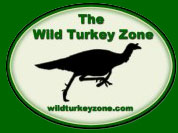|
Flocks
 Wild
turkeys segregate into flocks on the basis of sex
and, to some extent, age. In summer, fall and winter,
the basic unit is the family flock (brood) consisting
of the hen and her poults. One or more successful
hens often form multiple hen-brood flocks in late
summer and fall. Hens that are unsuccessful in nesting
form their own flocks. Adult males form flocks that
rarely associate with hens outside of the breeding
period. In late fall, young males separate from their
brood and form jake flocks. Occasionally, juvenile
gobblers will associate with adult gobblers. Wild
turkeys segregate into flocks on the basis of sex
and, to some extent, age. In summer, fall and winter,
the basic unit is the family flock (brood) consisting
of the hen and her poults. One or more successful
hens often form multiple hen-brood flocks in late
summer and fall. Hens that are unsuccessful in nesting
form their own flocks. Adult males form flocks that
rarely associate with hens outside of the breeding
period. In late fall, young males separate from their
brood and form jake flocks. Occasionally, juvenile
gobblers will associate with adult gobblers.
Spring brings about some
different flocking behavior. In March or early April,
the groups of bachelor gobblers will rejoin up with
all of the hens and form large groups as the mating
season begins. After 2 or 3 weeks, the breeding season
is beginning and the birds will break up again into
mating flocks consisting of 2 or 3 adult gobblers
and 5 - 15 hens. Each of these breeding flocks has
the 1 dominant gobbler who does all of the mating
and 1 or 2 subdominant birds who help fight off other
gobblers. The amount of hens will vary depending the
hen population in the area and the number of other
dominant gobblers. During this time, there are also
the same bunches of young males (or jakes)
who generally stay separate from the more dominant
gobblers during the mating season.
As the breeding season
winds down and the hens are sitting on their nests,
the gobblers will do considerable roaming in search
of willing hens and/or hens who have lost their nest
and are ready to be bred again. The gobblers will
eventually lose interest entirely and begin flocking
together in bachelor groups once again while the hens
go about the business of raising the poults..
Within a flock there
is a hierarchy or pecking order in which a rank of
dominance is established. Generally, older birds are
more dominant than are younger birds, and larger turkeys
dominate smaller turkeys. Males usually dominate females.
Home ranges of wild turkeys
vary greatly by season and individual. Generally,
home ranges tend to be largest from fall through spring.
At this time, gobblers use an average of 4-plus square
miles, which declines to an average of just more than
2 square miles in summer. However, on an annual basis,
individual gobbler home ranges may range from 3 to
11 square miles. Just after the poults are hatched,
a hen-brood flock's range may be limited to 100 acres,
which increase weekly after hatching date. This is
due to the small size and limited mobility of poults.
|

